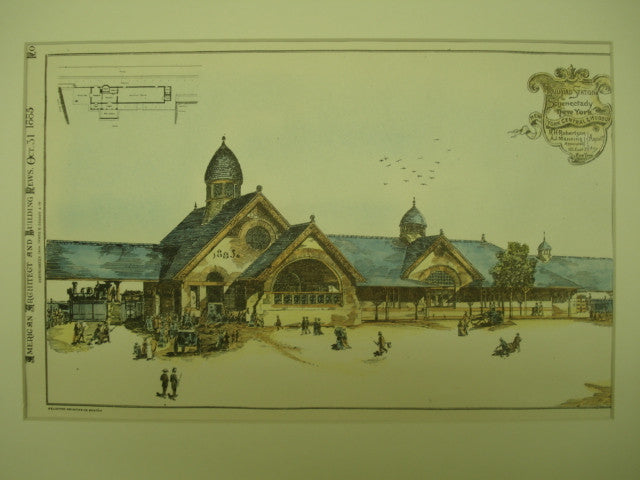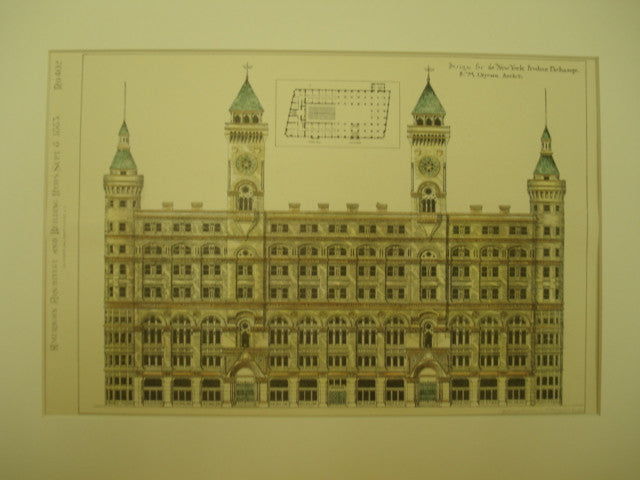News
The Nation Shakes in 1886 August 26 2015
This is the eleventh installment in our series of posts comparing significant events from a year in United States history with a few of our unique architectural plans from the same period. 1886, the topic of this installment, subsequently marks the eleventh year of the American Architect and Building News' existence.
Click on the pictures to find the plans below in our store!
In 1886 a general strike began among the workers of the United States to fight for better working rights within the nation. It culminated with the Haymarket affair at Haymarket Square in Chicago, Illinois. Originally a peaceful rally in support of those striking, the situation took a turn for the worse when someone threw a bomb towards the police line watching over the protests. Seven police officers and four citizens were ultimately killed in the resulting chaos. This Store Building on State St. for Ben Bagaman would soon be built near to the square, and its workers would soon be rewarded with the eight-hour workday fought for by their fellow workers. It was designed by Addison & Fielder.
On August 31 of 1886, an earthquake of magnitude 7.6 hit the coast of southeastern South Carolina, right near Charleston. Over 2,000 buildings in the area were destroyed and 60 lives were lost. Before this earthquake, almost no seismic activity was recorded in the history of the area, though it sits right near an active tectonic region. The St. James' Goosecreek Church in Charleston, South Carolina, designed by an unknown architect, likely was built after the earthquake hit the region. However, one would hope that all new buildings built in the area after the event would be reinforced to prevent such massive damage in the future.
The Nation Develops in 1885 August 24 2015
This is the tenth installment in our series of posts comparing significant events from a year in United States history with a few of our unique architectural plans from the same period. 1885, the topic of this installment, subsequently marks the tenth year of the American Architect and Building News' existence.
Click on the pictures to find the plans below in our store!
On February 16 of 1885, the first edition of the Dow Jones Industrial Average was published by Charles Dow, a major step in the development of the United States' economy. The average originally represented the dollar average of 14 of the most important United States stocks, while today it represents the average of 30. The original average consisted of 12 railroads, including the New York Central railroad. A beautiful station for the New York Central, as well as the Hudson River Railroad in Schenectady, New York is presented below, designed by R. H. Robertson & A. J. Manning.
In Chicago, Illinois, the tallest building in the world was completed in 1885. The Home Insurance Building was ten stories tall and the world's first skyscraper. It was the king for four years, until being passed by the Auditorium Building in 1889, also built in Chicago. This plan for the Adams Express Building for A.J. Cooper & Jas D. Carson from 1885 in Chicago only has eight stories, but was sure to tower over the rest of the city when its Geo. H. Eabrooke design was completed.
Times Change in 1883 August 19 2015
This is the eighth installment in our series of posts comparing significant events from a year in United States history with a few of our unique architectural plans from the same period. 1883, the topic of this installment, subsequently marks the eighth year of the American Architect and Building News' existence.
Click on the pictures to find the plans below in our store!
On May 24 of 1883, the Brooklyn Bridge in New York City opened to the public after 13 years of construction. The bridge connected Manhattan and Brooklyn, stretching over a mile across the East River. Just six days after it's opening, a stampede on the bridge occurred over rumors of the bridge's collapse, causing 12 people to be crushed in the resulting chaos. This design for the New York Produce Exchange by R. M. Upjohn would have been located nearby in Manhattan, and any Brooklyn or Long Island producers would now have an easy way to reach it and sell their wares. Upjohn is well-known for his Gothic Revivalist style, spurring the movements popularity in the country.
November of 1883 brought along the founding of universal time zones throughout the United States. The idea was put forth by the U.S. and Canadian railroad companies as a better means for planning arrivals and departures for their trains. Though the boundaries for the zones looked much different than they do today, the establishment of these ended much confusion throughout the nation with regard to scheduling. This combination United States Court House and Post Office designed by Jas. G. Hill in Quincy, Illinois would have benefited much from the zones' creation, as the Postal Service would have had a much easier time keeping their schedule.






